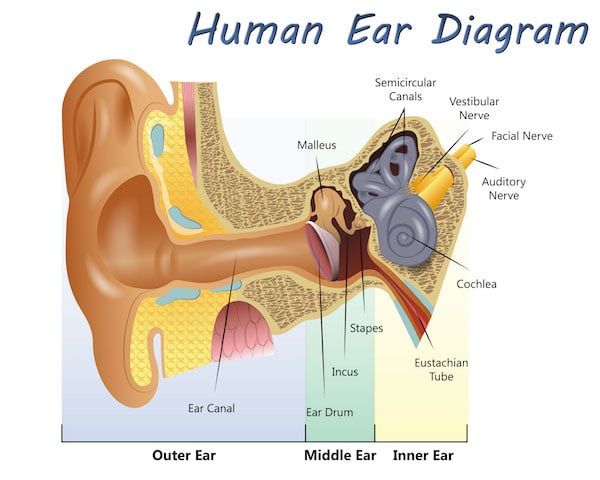The ear is a surprisingly complex organ responsible for collecting and processing sounds and transmitting them to the brain for interpretation. Many take hearing for granted, but according to your Green Valley audiologist, understanding the process is the key to treating hearing loss.
Structure of the Ear
The ear consists of three sections: the outer ear, middle ear and inner ear. Each plays an important role in hearing.
The outer ear is called the auricle or pinna. It is the external portion visible to others and is responsible for collecting sound waves and funneling them into the ear canal. There, they are amplified and sent to the tympanic membrane (eardrum), causing it to vibrate.
The middle ear consists of the auditory canal and tympanic membrane. When the eardrum vibrates, it stimulates movement of the ossicles, a trio of tiny bones comprised of the malleus (hammer), incus (anvil) and stapes (stirrup). The stapes attaches to the oval window, which connects the middle and inner ears.
The inner ear contains the cochlea, a fluid-filled structure where vibrations transmitted from the eardrum cause hair cells to move. This movement is converted to electrical impulses that traverse the auditory nerve to the brain. There, they are interpreted as sound and the hearing process is complete.
How the Shape of Your Ears Affects What You Hear
A new study published in the Journal of Neuroscience discovered that altering the shape of the ear could actually change someone’s ability to tell whether a sound came from above or below. Over time, their brain was able to adjust to their ear’s new shape and regain the ability to correctly pinpoint the direction of the sound just as accurately as before.
The researchers changed the shape of participants’ ears by filling the external part of the ear with a small piece of silicone. They then compared each individual’s ability to identify which direction a sound was coming from before and after the silicone insert. The results were compared and show a drastic difference.
Participants were then asked to return a week after wearing the molds in their ears. Their scores returned to the levels they were at before they had the insert. This told the researchers that the brain requires time and practice to adapt to a new ear shape.
An additional part of this study utilized MRI scanners to examine how participants’ brains were responding to sounds. They discovered that neurons responded less and less to sounds originating from higher locations. This means the neurons are likely representing height by the magnitude of their response.
In addition, when the participants first started wearing the earmolds, their auditory neurons were firing in a more disorganized manner, compared to how they were firing after a week of wearing the molds. These findings suggest that locating a sound in space requires your brain to incorporate not just the sound waves themselves but your own grasp of how your ears modify that sound.
The researchers are interested in finding more about how a sound’s height is perceived in the brain. This could lead to better hearing devices and improve our understanding of how the ear truly works.
To learn more about how the ear and brain work together to understand sounds, or to schedule an appointment for a hearing screening, contact our Green Valley audiologist today.
